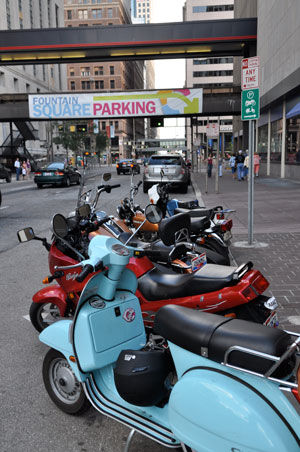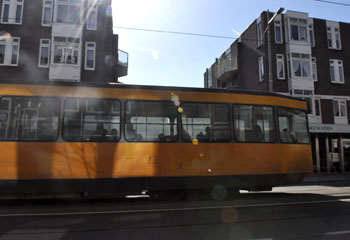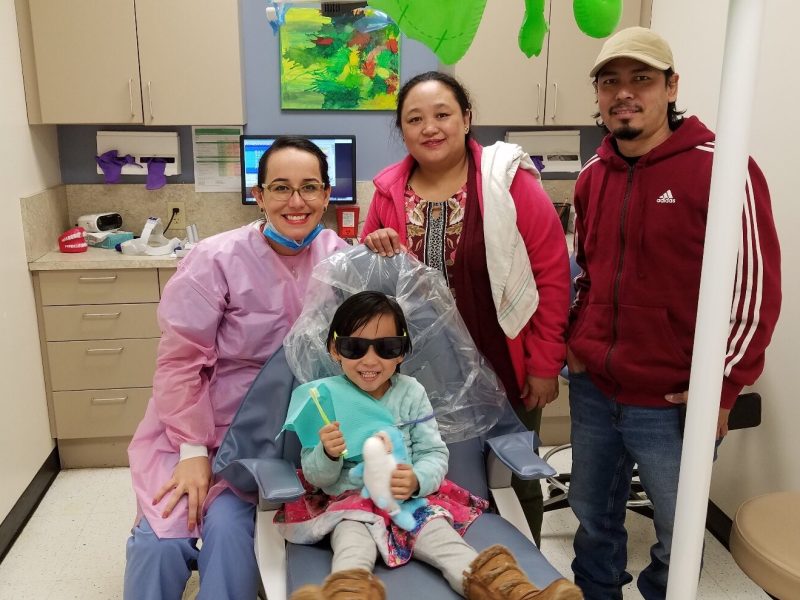Soapdish: Completing the streets of Cincinnati Part 2
Soapdish columnist, Casey Coston continues his two part examination of the Complete Street philosophy which some city leaders are adopting as way to re-imagine Cincinnati’s downtown.

 In last week’s edition, your trusty Soapdish reported back on the discussion at downtown’s Mercantile Library (no doubt the oldest membership library West of the Alleghenies (circa 1835)), which featured Complete Streets enthusiast and City Council fixture Roxanne Qualls, along with urban planner/architect Clete Benken, of the Kinzelman, Kline Gossman firm.
In last week’s edition, your trusty Soapdish reported back on the discussion at downtown’s Mercantile Library (no doubt the oldest membership library West of the Alleghenies (circa 1835)), which featured Complete Streets enthusiast and City Council fixture Roxanne Qualls, along with urban planner/architect Clete Benken, of the Kinzelman, Kline Gossman firm.
As noted on these very virtual pages last week, Cincinnati has been taking a few hesitant steps toward embracing certain aspects of the Complete Streets philosophy, recognizing that our streets serve not only their vehicular masters, but also the pedestrian, bicyclist, scooter aficionado, unicyclist, unicorn rider and anyone else looking to partake in the exterior urban tapestry of our fair city. To this end, the City’s Department of Transportation & Engineering has been working for the past eight months to develop comprehensive Complete Street design guidelines. The draft plan is expected to be completed this Fall, at which time they will launch a webpage where the public can go to view or download the draft guidelines, submit feedback online and provide additional commentary.
 While admirable in the abstract, putting these theories to work can be problematic, and many have voiced concerns over certain Complete Streets tenets. Take, for example, the fundamental concept of reinstituting two way traffic on downtown streets. Benken worked closely with Lexington in instituting their 2008 Master Plan, which converted all but one of the downtown streets back to two way, and is more than familiar with the road blocks which can be thrown up. For example, many would argue that there is no way a narrow street such as downtown Cincinnati’s 4th Street could be converted to two way traffic replete with bike lanes. Au contraire, cites the Complete Streets theorist, noting that, with careful planning and synergistic engineering, such a conversion can and has been done with a modicum of disruption, and even narrow spaces can integrate bikes, cars and pedestrians if done properly.
While admirable in the abstract, putting these theories to work can be problematic, and many have voiced concerns over certain Complete Streets tenets. Take, for example, the fundamental concept of reinstituting two way traffic on downtown streets. Benken worked closely with Lexington in instituting their 2008 Master Plan, which converted all but one of the downtown streets back to two way, and is more than familiar with the road blocks which can be thrown up. For example, many would argue that there is no way a narrow street such as downtown Cincinnati’s 4th Street could be converted to two way traffic replete with bike lanes. Au contraire, cites the Complete Streets theorist, noting that, with careful planning and synergistic engineering, such a conversion can and has been done with a modicum of disruption, and even narrow spaces can integrate bikes, cars and pedestrians if done properly.
Moreover, there is no actual need for a beautiful and historic urban thoroughfare such as 4th to serve as the arterial gateway to northbound Interstate 75. Interestingly enough, when Ft. Washington Way was constructed, an access ramp from 3rd to 75 North was constructed, ostensibly intended to serve as the feeder to the freeway and thereby alleviating the need to use 4th street as an urban evacuation route. Unfortunately, however, that dusty ramp remains inexplicably closed, and even Qualls did not have a ready answer as to why.
Additionally, it’s not just downtown that could gain from such an approach. The sprawlburbs could also certainly benefit from the addition of amenities such as sidewalks and other exotic urban accoutrements (see, https://soapboxmedia.com/47soapdish). Qualls noted that converting McMillan and Taft back to two way traffic would be at the top of  any Complete Streets agenda implemented in Cincinnati, observing that the conversion of those streets to one way literally “destroyed” Walnut Hills and the Peebles Corner neighborhood. Piping in on that theme, Benken observed that the conversion of one way streets to two way, while complex, can work if coordinated with a variety of initiatives. For example, trolleys and streetcars can encourage more people to walk and leave their cars outside of the downtown core, thereby freeing up space by alleviating the need to have cars parked on the streets at all hours of the day, as well as minimizing the need for the downtown streets to single-mindedly act as freeway funnels In addition, it seems that the mammoth supply of parking spaces being generated by the Banks project, when provided with a streetcar to link up, would also assist in alleviating the need to park cars on downtown streets. As Benken put it, planners need to put downtown on a “road diet,” eliminating the consumption of spaces used for parking and thereby freeing it up for a balanced diet of autos, floating bike lanes and pedestrian access.
any Complete Streets agenda implemented in Cincinnati, observing that the conversion of those streets to one way literally “destroyed” Walnut Hills and the Peebles Corner neighborhood. Piping in on that theme, Benken observed that the conversion of one way streets to two way, while complex, can work if coordinated with a variety of initiatives. For example, trolleys and streetcars can encourage more people to walk and leave their cars outside of the downtown core, thereby freeing up space by alleviating the need to have cars parked on the streets at all hours of the day, as well as minimizing the need for the downtown streets to single-mindedly act as freeway funnels In addition, it seems that the mammoth supply of parking spaces being generated by the Banks project, when provided with a streetcar to link up, would also assist in alleviating the need to park cars on downtown streets. As Benken put it, planners need to put downtown on a “road diet,” eliminating the consumption of spaces used for parking and thereby freeing it up for a balanced diet of autos, floating bike lanes and pedestrian access.
While, as noted above, Cincinnati has not taken a full-fledged cannonball plunge into the Complete Streets kool-aid, there are inklings here and there edging towards tossing off the yoke of auto-dominance. Take for example the 2 wheel parking projects, as well as the recently announced Sharrows Pilot Project, launched in May of this year. The Sharrows Project seeks to explore the opportunities of shared lane pavement markings for bikes and autos. http://www.cincinnati-oh.gov/sharrows/ The intent of the Sharrows Pilot Project is not a bike lane per se, but at least a recognition that bikes and cars can in fact share the roadways without t-boning a passing cyclist with your car door or passing too close to the rider. At this point, the modest proposal (there are three initial test locales: Clifton Ave (McMillan St to Ludlow Ave), Ludlow Ave (Bowdle Place to Clifton Hills) and Madison Rd (Beechcrest Lane to Torrence Parkway)). Hopefully, this is just a beginning, lest the sharrows in Cincinnati go the way of such past projects as the Victory Parkway bike-lane to nowhere and the like.
 While admittedly modest, the Sharrows Pilot Project is heartening in that Cincinnati, as a city, is beginning to think about urban planning in a manner in which automobiles don’t dictate the activities that people enjoy and how people lead their lives. Let me be clear, however – I’m not espousing the end of the auto, not by any stretch of the imagination. What I do have a problem with, however, is how the auto dominates the urban landscape. The idea that I can bike and scooter to work, in a city which encourages biking and scootering to work, is certainly a step in the right direction, and a boon for any city seeking to position itself as a progressive and up and coming live/work urban destination. Now let’s try and convert 4th to two way traffic, open up the dormant 3rd street access ramp to I-75 North and see what kind of excitement happens on 4th Street (as a “pilot project,” bien sur).
While admittedly modest, the Sharrows Pilot Project is heartening in that Cincinnati, as a city, is beginning to think about urban planning in a manner in which automobiles don’t dictate the activities that people enjoy and how people lead their lives. Let me be clear, however – I’m not espousing the end of the auto, not by any stretch of the imagination. What I do have a problem with, however, is how the auto dominates the urban landscape. The idea that I can bike and scooter to work, in a city which encourages biking and scootering to work, is certainly a step in the right direction, and a boon for any city seeking to position itself as a progressive and up and coming live/work urban destination. Now let’s try and convert 4th to two way traffic, open up the dormant 3rd street access ramp to I-75 North and see what kind of excitement happens on 4th Street (as a “pilot project,” bien sur).
In her opening remarks, Qualls quoted the esteemed urban writer, activist and titular urbanista godhead Jane Jacobs, who wrote, in her 1961 masterpiece The Death and Life of Great American Cities, that the “erosion of cities by automobiles entails so familiar a series of events that they hardly need describing. The erosion proceeds as a kind of nibbling.” Complete Streets is not intended to eradicate the automobile, but rather to take a bite back at the endless nibbling which erodes our urban cores. Cincinnati would be well served to continue biting back, and the design plan being introduced this Fall is an admirable beginning. Trust me, it’s the right thing to do, just ask Portland, Austin, New York, Chicago, Seattle, Boulder, Charlotte et al. Really folks, lessening our dependence and devotion to the automobile is not the worst thing that could happen in this environment.
Photography by Scott Beseler














